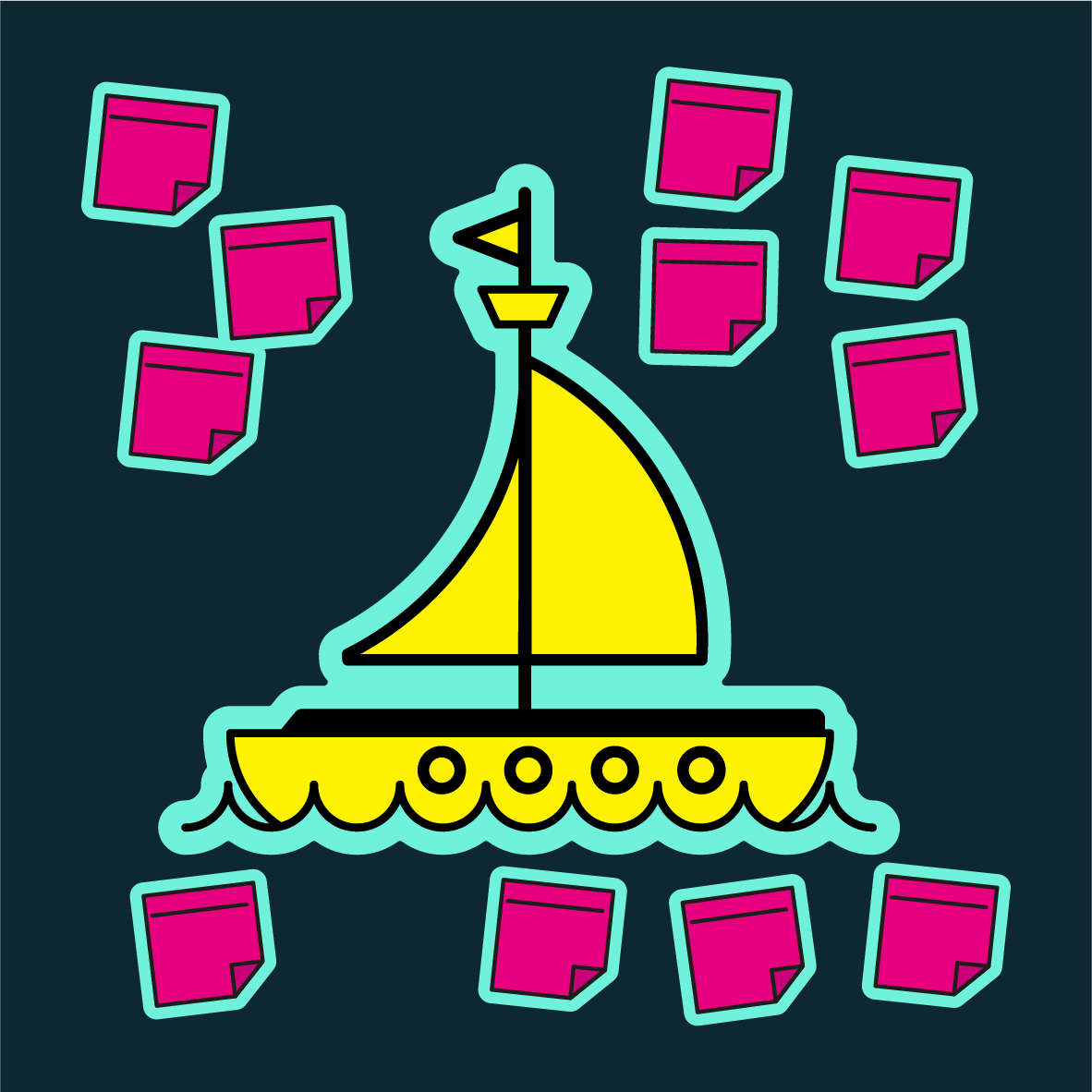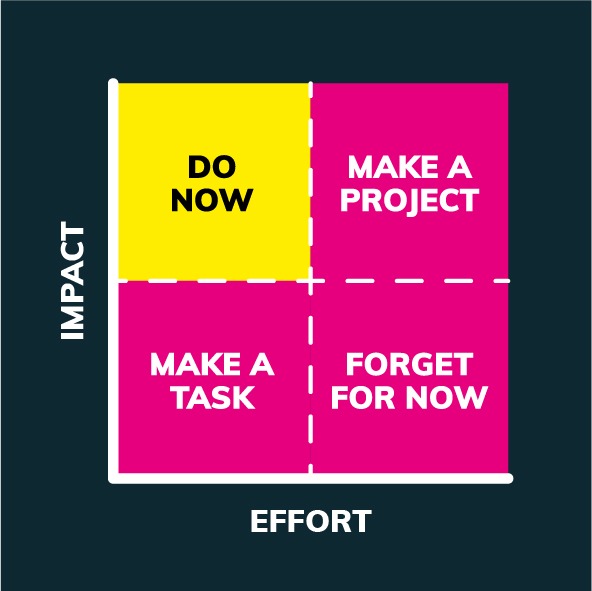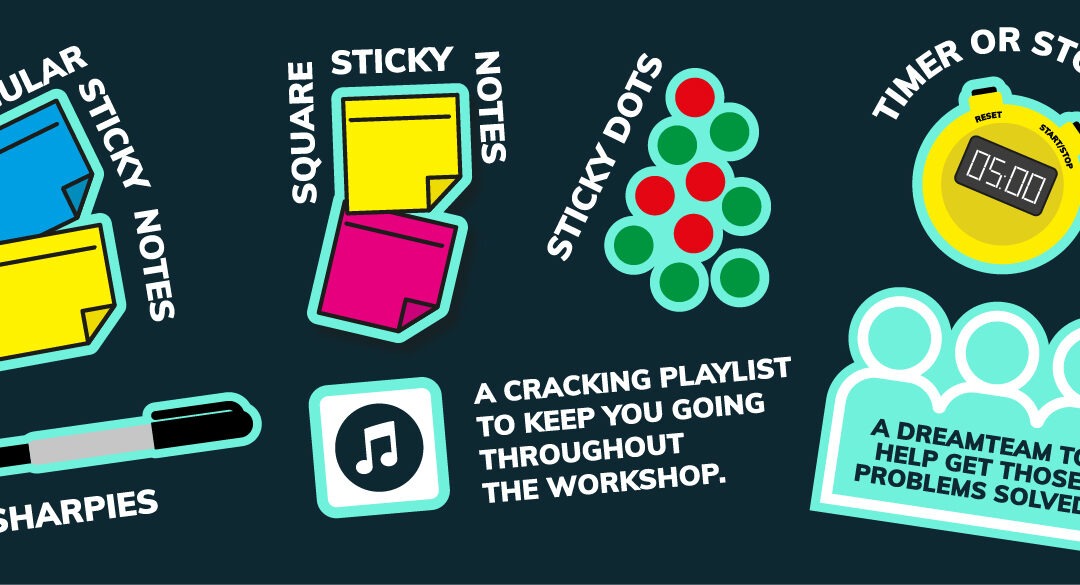Got a problem that needs to be solved within your business but are unsure where to start? We have a process that can help you identify, define, and resolve any problem in your company.
We can help you identify, define and solve problems through our Lightning Decision Jam (LDJ), a two-hour workshop that allows you and your team to work efficiently and effectively through issues within your business.
So, how do you start? It’s easy, with these seven simple steps!
First things first, grab these seven tools, they will come in handy during the workshop to complete the seven steps:
Step 1: Start with things that are working
10 Mins
See the image of the sailboat below? Draw one of those up on your whiteboard, waterlines, and all. The top half of the boat represents what’s working well and the bottom half shows what’s holding your business back.
Once that’s complete, gather your team together and identify everything that’s working well; This should take around four minutes and can be as simple as ‘Our team work well together’. Try to write as many as possible and stick to one idea per sticky note.
After the four minutes are up take it in turns to stick your post-it notes to the top of the sailboat.

Step 2: Capture all the problems
5 Mins
Now that you’ve highlighted everything that’s working well, it’s time to focus on the tougher spots, areas that you might feel are a place of concern. Again, write down as many as possible, the pain points will help you resolve and develop a solution later in the workshop!
Once the four minutes are up, take it in turns to stick everyone’s ideas to the bottom of the sailboat – this should take around a minute to do.
Step 3: Prioritise problems
3 mins
It’s time to vote!
Each team member should now have three sticky dots that have been given to them by the moderator. Looking at the challenge areas, you should now consider the most relevant to solve and place their dots on that post-it. This should be completed without any discussion.
You can vote on your own challenge areas, and you can vote more than once if it’s a challenge statement you feel strongly about.
Step 4: Reframe the problems as standardised challenges
3 mins
Once Step 3 is complete, it’s time to reframe the problems. This is usually completed by the moderator in the form of a standardised challenge, helping you to create an array of solutions.
This process can be aided by a sticky note containing a ‘How Might We’ (HMW) solution, for example, if you have a sticky note that says ‘Lack of communication’ this can be rephrased to say ‘HMW – Make sure we communicate better.’
This will need to be repeated for each problem statement that had multiple votes.
Step 5: Ideate without discussion
6 mins

During Step 5 each team member is given five minutes to write as many solutions as possible for the HMW, this should be done independently.
Removing discussion from the workshop ensures a variety of solutions to the problem/ challenge statement are allowed to emerge.
For instance, going back to our example from Step 4, to communicate better we might use Monday.com to ensure all projects are up to date and everyone in the team is aware of who is responsible for the task and when it needs completing.
Step 6: Prioritise solutions
5 mins
Once you have written out multiple solutions to the problem, it’s time to vote on which ones you think would be best to solve the HMW.
This is a very similar exercise to Step 3 however, during this session, you will be allocated six voting dots each and up to four minutes to prioritise which solution you think is best.
Step 7: Decide what to execute and make solutions actionable
15 mins
Finally, it’s time to decide on what to execute. This is completed using an effort / impact scale, helping to see how much effort is required to execute the solutions. This helps to judge which solutions should be tried now and which ones might take a little more time to implement.
- ‘Effort’ is how much time and energy you think it will take to implement.
- ‘Impact’ is the degree to which you think it would solve the issues.
Top Tip
The moderator needs to be proactive during this step as they are the ones who will open the discussion, reviewing each solution one at a time to add them to the effort/ impact scale.
Below is a list of what the moderator needs to do:
- Draw the effort / impact scale.
- Start with the impact:
- Take the top-voted solution and hover over the scale.
- Ask participants to express their thoughts by saying ‘higher or lower’.

The moderator should move the sticky note up or down the impact axis until the team members stop saying higher or lower. The moderator should also stop any conversation that exceeds 20 seconds.
Once the impact has been determined, the moderator should ask the group ‘is the effort higher or lower?’ and asks participants to say ‘left (least effort) or right (most effort)’.
The moderator then needs to move the sticky note left or right until the group stops saying ‘left or right’.
This process should be repeated for the other top-voted solutions.
Once the process is complete, you should have something that looks like this:
You now have a clear overview of the high-impact solutions and those that will take more effort. The moderator should quickly mark the sticky notes in the ‘sweet-spot’(hight-impact but minimum effort) using an alternative colour sticky dot to help to identify them later.
Another way to organise the board would be to use definitions (see below), this helps to decide how and when you might act on the ideas.

There you have it, the seven simple steps to solving any business problem and gaining the key to success.
This exercise is a great way to get your team used to problem-solving and experimenting with a new approach without overthinking and over-discussing. A fun yet effective approach to problem-solving!
Keen to adapt this technique within your team?

